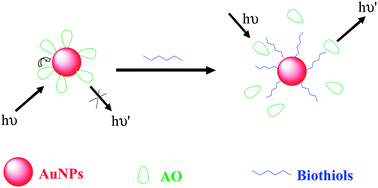Selective “turn-on” fluorescent sensing for biothiols based on fluorescence resonance energy transfer between acridine orange and gold nanoparticles
Abstract
This study reports a novel fluorescence resonance energy transfer (FRET) system between

* Corresponding authors
a
Anhui Key Laboratory of Chemo/Biosensing, Anhui Key Laboratory of Functional Molecular Solids, College of Chemistry and Materials Science, Anhui Normal University, Wuhu, China
E-mail:
fgao@mail.ahnu.edu.cn
Fax: +86-553-3869302
Tel: +86-553-3869302
This study reports a novel fluorescence resonance energy transfer (FRET) system between

 Please wait while we load your content...
Something went wrong. Try again?
Please wait while we load your content...
Something went wrong. Try again?
F. Gao, Q. Ye, P. Cui, X. Chen, M. Li and L. Wang, Anal. Methods, 2011, 3, 1180 DOI: 10.1039/C1AY05073G
To request permission to reproduce material from this article, please go to the Copyright Clearance Center request page.
If you are an author contributing to an RSC publication, you do not need to request permission provided correct acknowledgement is given.
If you are the author of this article, you do not need to request permission to reproduce figures and diagrams provided correct acknowledgement is given. If you want to reproduce the whole article in a third-party publication (excluding your thesis/dissertation for which permission is not required) please go to the Copyright Clearance Center request page.
Read more about how to correctly acknowledge RSC content.
 Fetching data from CrossRef.
Fetching data from CrossRef.
This may take some time to load.
Loading related content
